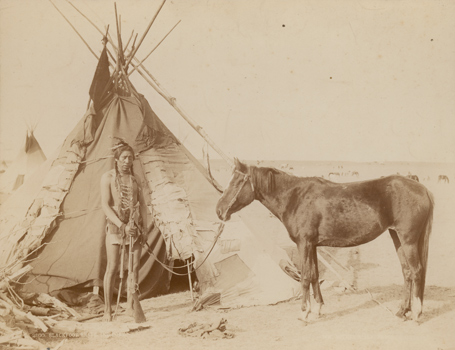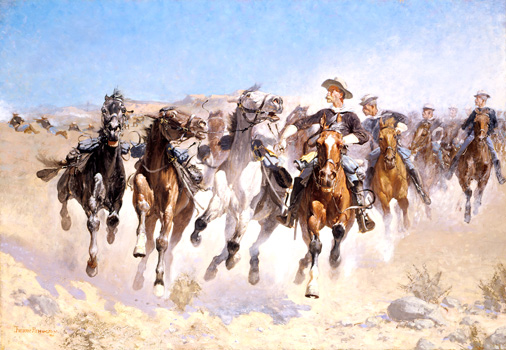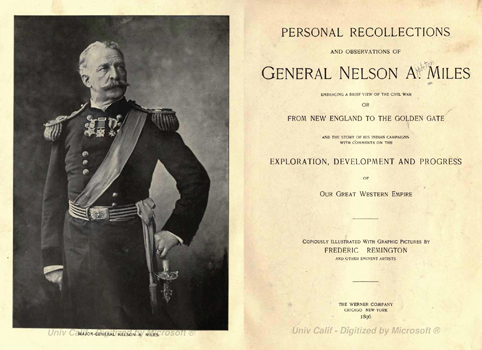
February 17–May 4, 2008

image gallerY
























Artist unknown
Remington Painting "An Indian Trapper"
c. 1889
Gelatin silver print
Frederic Remington Art Museum, Ogdensburg, New York
Remington is shown here working on An Indian Trapper, comfortably seated in a rocking chair in his studio, surrounded by other paintings, artifacts, and props. Numerous differences exist between the painting as seen in this photo and the finished work. For example, note the rocky foreground, the horse's shadow and tail, and the horse and rider in the distance.
Frederic Remington
(1861-1909)
An Indian Trapper
1889
Oil on canvas
Amon Carter Museum, Fort Worth, Texas
Incorporating details of dress and weaponry collected during the artist's 1887 visit to the Blackfoot reservation in Alberta, Remington's Indian Trapper resembles the figure "in winter costume" that appears in his illustration "In the Lodges of the Blackfeet Indians."
William McFarlane Notman
(1826-1891)
Blackfoot Brave and Pony Near Calgary
1889
Albumen print
Frederic Remington Art Museum, Ogdensburg, New York
William McFarlane Notman produced promotional images for the Canadian Pacific Railway, including this depiction of a Blackfoot man. Remington had photographs taken at the Notman studios in Montreal in December of 1889 and probably acquired these pictures at that time.
Frederic Remington
(1861-1909)
Aiding a Comrade (Past All Surgery)
c. 1890
Oil on canvas
The Museum of Fine Arts, Houston, Texas. The Hogg Brothers Collection, gift of Miss Ima Hogg
Remington exhibited this painting in 1890 under the title Past All Surgery, leaving little doubt to the fallen rider's fate. Renamed Aiding a Comrade, this painting and the Clark's Dismounted share the dramatic effect of horses galloping directly toward the viewer, a formula that brought Remington earlier success with the 1889 painting A Dash for the Timber(Amon Carter Museum, Fort Worth, Texas).
Frederic Remington
(1861-1909)
Book of Animals
c. 1890s
Scrapbook
Frederic Remington Art Museum, Ogdensburg, New York
Remington compiled books of clippings to verify details and enhance the accuracy of his images. For example, if called upon for an illustration featuring a badger, a creature not easily found in the suburbs of New York City, he could quickly refer to an image from his "Book of Animals." Horses dominate this volume.
Frederic Remington
(1861-1909)
Dismounted—The Fourth Troopers Moving the Led Horses
1890
Oil on canvas
Sterling and Francine Clark Art Institute, Williamstown, Massachusetts
Columns of four riders are a standard cavalry formation, enabling three men to quickly dismount and fight on foot while the fourth trooper leads the horses out of danger. George Armstrong Custer described this tactic in his autobiography, My Life on the Plains, published two years before his defeat at the Battle of the Little Bighorn in 1876.
"General Miles and His Escort"
Halftone print in Pony Tracks, written and illustrated by Frederic Remington (New York and London: Harper and Brothers, 1903)
Sterling and Francine Clark Art Institute, Williamstown, Massachusetts
Remington's experiences traveling with General Miles were directly useful to the artist, providing material for numerous stories, illustrations, and paintings. Pony Tracks, Remington's first published collection of writings, is dominated by stories inspired by Remington's association with General Miles.
Frederic Remington
(1861-1909)
Pursuing the Indians
c. 1896
Oil on canvas
Cynthia L. and William E. Simon, Jr.
Pursuing the Indians and Plains Indians Riding to War were painted to illustrate Nelson Miles's autobiography. Nearly monochromatic, paintings like these were a common method of preparing images for black-and-white illustrations.
Personal Recollections and Observations of General Nelson A. Miles...With Graphic Pictures by Frederic Remington
(Chicago and New York: The Werner Company, 1896)
Publisher's binding, gilt
Sterling and Francine Clark Art Institute, Williamstown, Massachusetts
Like Remington's father, Miles distinguished himself as a volunteer in the Civil War. Miles led troops responding to the Battle of Little Bighorn in 1876–77 and pursued Chief Joseph in 1877 and Geronimo in 1886. Miles was Commanding General of the 7th Cavalry, the regiment responsible for the attack at Wounded Knee in 1890, described by Miles himself as a massacre. He was not personally involved in the slaughter and condemned the actions of the commanding officer.
Frederick Remington
(1861-1909)
Friends or Foes? (The Scout)
c. 1902-5
Oil on canvas
Sterling and Francine Clark Art Institute, Williamstown, Massachusetts
This painting was exhibited in 1905 as Friends or Foes? When Sterling Clark acquired the painting in 1951, it was called The Scout—Friends or Enemies. "Friends or Enemies" was probably taken from a 1908 inventory kept by Remington. The origin of "The Scout" is unclear. The 1905 exhibition included another Scout that also appears in the inventory immediately above "Friends or Enemies," so "The Scout" could be a transcription error.
Frederic Remington
(1861-1909)
A Reconnaissance
1902
Oil on canvas
Private collection
In the nocturnes of the 1900s, danger is often displaced to the far periphery of vision, along the horizon or hidden beyond the canvas. A 1903 review described how A Reconnaissance "suggests peril of some kind . . . . One feels that the danger, if danger there be, lurks within or beyond the trees."
Frederic Remington
(1861-1909)
Trail of the Shod Horse
1907
Oil on canvas
Princeton University Art Museum. Gift of Francis Earle, Class of 1909, for the Philip Ashton Rollins, Class of 1889, Collection of Western Americana; transferred from the Princeton University Library
Trail of the Shod Horse is about observation and the close scrutiny of trace evidence, about apprehension, meaning both the sense of anxiety or foreboding and the need to accurately grasp the situation in order to understand the evidence at hand. The safety of the party requires that the tracks in the snow be correctly recognized and interpreted.